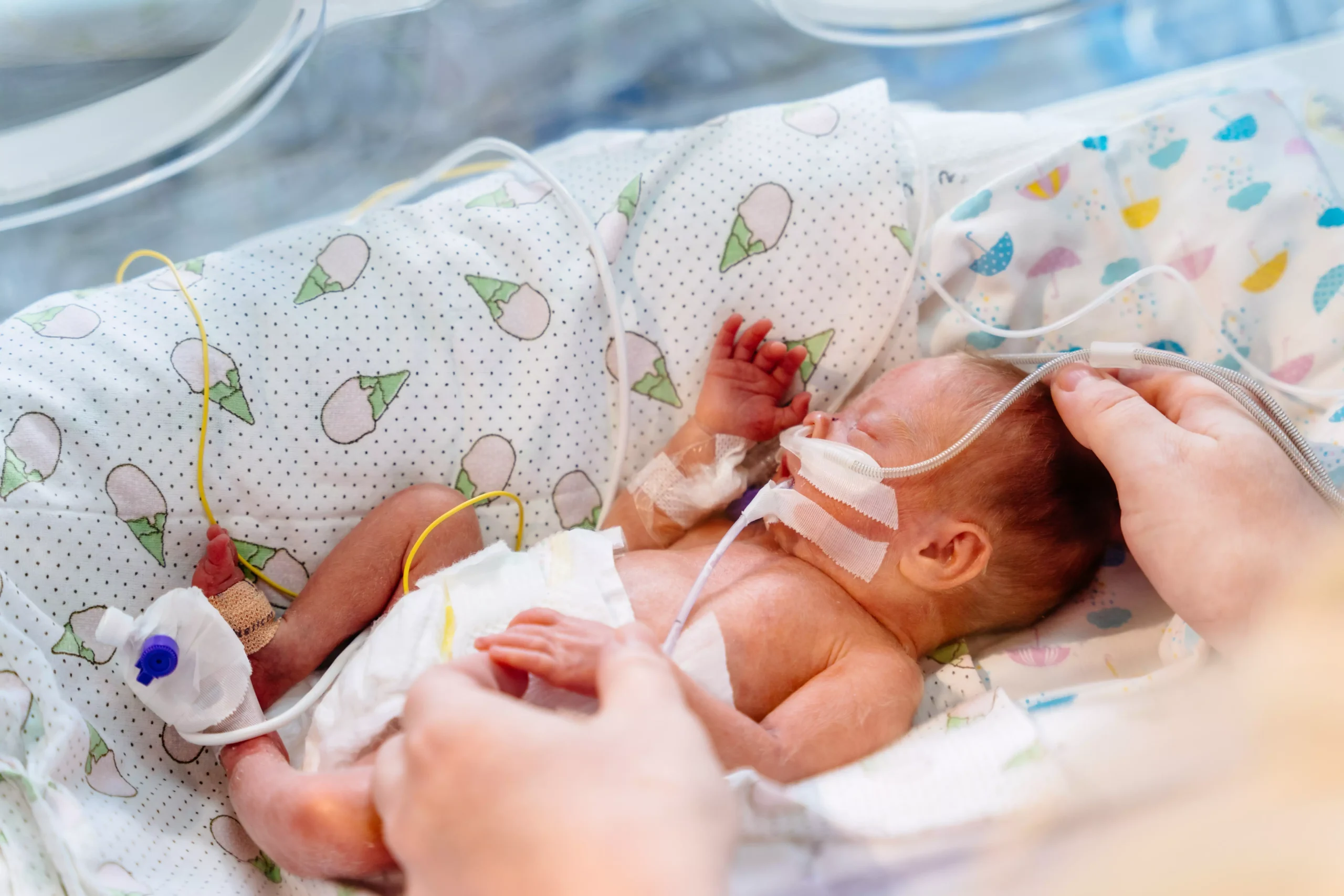Respiratory distress syndrome (RDS)
Respiratory distress syndrome (RDS)
Neonatal RDS is a respiratory condition that begins around birth and worsens over the first few days of life.1 It is primarily caused by a lack of a substance known as surfactant as well as underdeveloped lungs, and its incidence is inversely correlated with gestational age, occurring more frequently and severely in smaller, premature infants.1–3
Despite improved treatments such as corticosteroids, surfactants, and advanced respiratory care, RDS continues to be a significant cause of illness and death in preterm infants.2
What is surfactant?
Surfactant is an essential component of functioning lungs as it reduces surface tension at the air-water interface in the alveoli, preventing their collapse at end-expiration and thereby decreasing the work of breathing.4
How surfactant works.

The importance of improving RDS care
The European Consensus Guidelines on the management of RDS award their highest level of recommendation for the use of an animal-derived surfactant preparation (A1 recommendation).1
Approximately 47% of childhood deaths globally occur during the newborn period, with RDS identified as a significant contributor, highlighting the critical need to optimise its management.5,6
The WHO and UNICEF identified the management of complications of prematurity, such as RDS, as a high-yield area for improving critical care of newborns in the Every Newborn Action Plan.6,7
How CUROSURF was developed for the treatment of RDS
Neonatology Education,
Skills and Training
Chiesi is committed to advancing medical education with innovative and comprehensive training programmes, aiming to equip HCPs with the essential knowledge, skills, and expertise to thrive in the dynamic field of neonatology.
In investing in your professional growth and staying at the forefront of a rapidly evolving medical landscape!
See the information below for some common clinical signs and risk factors for neonatal RDS.
Early recognition and effective management of RDS are essential.
Untreated RDS can result in respiratory failure, and prompt, effective management is crucial since it can lead to another condition known as bronchopulmonary dysplasia (BPD).8
Despite significant advancements in neonatal care, there has been limited progress in lowering BPD rates and it remains the most common adverse outcome for infants born <30 weeks of gestation and is the most common chronic lung disease in infancy.8,9
Surfactant deficiency cycle
Recognise the early signs of RDS
Neonatal RDS typically presents in premature infants immediately or shortly after birth and clinical signs may include:2,10
About the advantages of early RDS treatment
Understand predisposing factors
RDS is a multifactorial disease and, though the definition is imprecise, there are a variety of risk factors including:11,12
Explore our range of educational resources here.
Abbreviations
BPD, bronchopulmonary dysplasia; ECG, European Consensus Guidelines; RDS, respiratory distress syndrome; SmPC, Summary of Product Characteristics; UNICEF, United Nations Children’s Fund; WHO, World Health Organization.
References
- Sweet DG, et al. European Consensus Guidelines on the Management of Respiratory Distress Syndrome: 2022 Update. Neonatology. 2023;120(1):3–23.
- Yadav S, et al. Neonatal Respiratory Distress Syndrome. [Updated 2023 Jul 25]. In: StatPearls [Internet]. Treasure Island (FL): StatPearls Publishing; 2024 Jan-. Available at https://www.ncbi.nlm.nih.gov/books/NBK560779/. Accessed December 2024.
- Chakraborty M and Kotecha S. Pulmonary surfactant in newborn infants and children. Breathe 2013;9(6): DOI 10.1183/20734735.006513.
- Han S and Mallampalli RK. The Role of Surfactant in Lung Disease and Host Defense against Pulmonary Infections. Ann Am Thorac Soc 2015;12(5):765–774.
- WHO: Newborn mortality. Available at https://www.who.int/news-room/fact-sheets/detail/newborn-mortality. Accessed December 2024.
- Muhe LM, et al. Major causes of death in preterm infants in selected hospitals in Ethiopia (SIP): a prospective, cross-sectional, observational study. Lancet Glob Health. 2019;7(8):e1130-e1138. doi: 10.1016/S2214-109X(19)30220-7.
- WHO: Every Newborn Action Plan. Available at https://iris.who.int/bitstream/handle/10665/127938/9789241507448_eng.pdf?sequence=1. Accessed December 2024.
- Thébaud B, et al. Bronchopulmonary dysplasia. Nat Rev Dis Primers 2019;5(1):78.
- Davidson LM and Berkelhamer SK. Bronchopulmonary Dysplasia: Chronic Lung Disease of Infancy and Long-Term Pulmonary Outcomes. J Clin Med. 2017;6(1):4.
- Jha K, et al. Transient Tachypnea of the Newborn. [July 2023]. In: StatPearls [Internet]. Treasure Island (FL): StatPearls Publishing; 2024 Jan-. Available from: https://www.ncbi.nlm.nih.gov/books/NBK53735. Accessed December 2024.
- Li Y, et al. Maternal diabetes mellitus and risk of neonatal respiratory distress syndrome: a meta-analysis. Acta Diabetol. 2019;56(7):729–740.
- Rennie JM, Roberton NRC. In: Rennie & Roberton’s textbook of neonatology. 5th Ed. E-book;2012:469–470.
IE-CUR-2400040 | December 2024
Adverse event reporting
For the UK: Adverse events should be reported. Reporting forms and information can be found at https://yellowcard.mhra.gov.uk/ or search for MHRA Yellow Card in the Google Play or Apple App Store. Adverse events should also be reported to Chiesi Limited on 0800 0092329 (UK) or PV.UK@Chiesi.com.
For Ireland: Adverse events should be reported to HPRA Pharmacovigilance – www.hpra.ie. Adverse events should also be reported to Chiesi Limited on 1800 817459 (IE) or PV.UK@Chiesi.com.